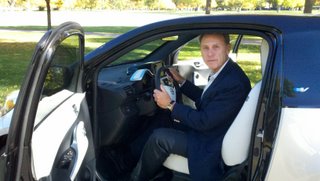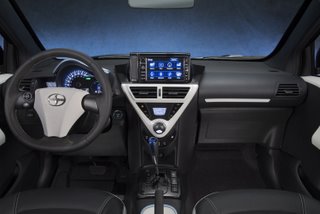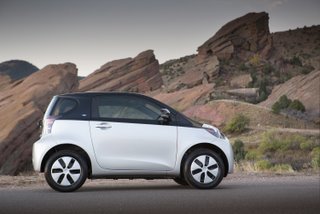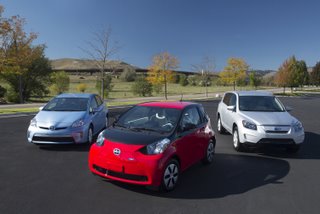Driving Toyota’s New City Electric Car

As I drive Toyota’s sporty new electric car, sun streams through the red and yellow fall colors that grace Denver’s downtown. This is the new 2013 Scion iQ EV, Toyota’s fourth electric car that joins the Prius Plug-in Hybrid, FCHV, and the RAV4 EV all-electric SUV. This iQ-EV is a micro-compact all-electric city car. You can be over 6 feet and easily slide into the two front bucket seats, but you better be a small child to fit in the back two seats. In practicality, you would lower the back 2 seats for cargo.
 The car glides through curves and accelerates with ease. For lots of regenerative braking, I shift this automatic into “B” which uses the motor as a generator to put energy into the lithium battery, causing the car to slow quickly when I take my foot of the accelerator. There are three driving modes to select from: D range controls the vehicle to use the least amount of power during city driving; S range increases acceleration performance for brisker driving; and a B range that maximizes regenerative braking efficiency.
The car glides through curves and accelerates with ease. For lots of regenerative braking, I shift this automatic into “B” which uses the motor as a generator to put energy into the lithium battery, causing the car to slow quickly when I take my foot of the accelerator. There are three driving modes to select from: D range controls the vehicle to use the least amount of power during city driving; S range increases acceleration performance for brisker driving; and a B range that maximizes regenerative braking efficiency.
Maximum output from the drivetrain is 47 kW (63 hp) with a maximum torque of 120 lbs.-ft. In S range the iQ EV accelerates from zero to 60 mph in 13.4 seconds and from 30 to 50 mph in 7 seconds. Its top speed is 78 mph.
Sorry, Toyota is only placing a small number of these city cars into car sharing and campus programs. The iQ-EV shows more pep than the Smart Electric that I drove in San Diego’s car2go car sharing. It doesn’t have quiet the power of the BMW ActiveE that I drove in San Francisco’s Drive Now car sharing. It has the power, but not the room of the Mitsubishi I that I drove months ago.
Performance and Efficiency
 The iQ EV features Toyota’s newly developed high-output lithium-ion battery delivers power at 104 Wh/km. The small and light weight battery pack helps vehicle range and does not diminish interior space. In ideal stop and go driving conditions, the 12 kWh battery provides an estimated range of up to 50 miles on a full charge. The vehicle can be fully charged in approximately 3 hours at 240V. Its 78-inch wheel base and 13.5 foot turning radius makes the iQ EV highly maneuverable in congested areas where streets are narrow and parking is at a premium.
The iQ EV features Toyota’s newly developed high-output lithium-ion battery delivers power at 104 Wh/km. The small and light weight battery pack helps vehicle range and does not diminish interior space. In ideal stop and go driving conditions, the 12 kWh battery provides an estimated range of up to 50 miles on a full charge. The vehicle can be fully charged in approximately 3 hours at 240V. Its 78-inch wheel base and 13.5 foot turning radius makes the iQ EV highly maneuverable in congested areas where streets are narrow and parking is at a premium.
The iQ EV improves range by using lightweight materials, electric accessories, and an advanced lithium battery. The iQ EV is replete with energy conserving features such as regenerative braking, heat pump air conditioning with a pre-conditioning option, LED high-mounted stop light, heated front seats, and a heated windshield defroster.
Styling
The iQ EV’s styling is simple and bold. On the exterior, the front bumper’s simply constructed charging port lid emphasizes the EV’s iconic lack of an upper grille. Its trapezoidal motif highlights the appearance of a low center of gravity. A wide rear bumper conveys a strong stance. Two exterior colors are available: Silver and Super Red.
The interior features a high-contrast black and white color scheme with metallic and ice-blue accents. The leather wrapped steering wheel and white steering pad feel just right.
Navigation, Music, Safety
The radio plays your favorite stations or music from your iPhone or Droid. The iQ EV is equipped with an HDD navigation system and 7-inch Video Graphics Array LCD, which displays audio information or vehicle information (such as power consumption and energy flow information) in a split screen with the map on the main navigation screen. An available range map displays an estimate of the distance the iQ EV can travel on its current state of charge.
The iQ EV is equipped with 11 SRS (Supplemental Restraint System) airbags including knee, side, seat cushion, front and rear curtain, and a rear window curtain. The iQ EV’s multiple load path body is designed to absorb and disperse frontal collision impacts through the body shell. A cross hatched constructed battery frame joined to the body frame helps enhance the rigidity of the cabin and helps disperse the energy of collisions from any angle.
The iQ EV comes standard with the Star Safety System™, which combines Vehicle Stability Control (VSC), Traction Control (TRAC), Anti-lock Braking System (ABS), Electronic Brake-force Distribution (EBD), Brake Assist (BA) and Smart Stop Technology (SST). The iQ EV is also equipped with Hill start assist control and a vehicle proximity notification system to alert pedestrians of the vehicle’s approach.
 This new all-electric iQ EV will do well in car sharing and campus tests. The larger RAV4 EV and FCHV will do well in fleet applications that require room for 5, more cargo, and longer range. The Toyota Prius Plug-in Hybrid is now selling at local dealers.
This new all-electric iQ EV will do well in car sharing and campus tests. The larger RAV4 EV and FCHV will do well in fleet applications that require room for 5, more cargo, and longer range. The Toyota Prius Plug-in Hybrid is now selling at local dealers.
